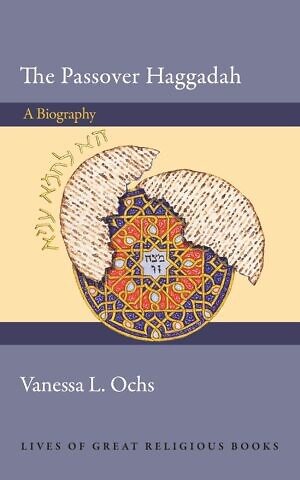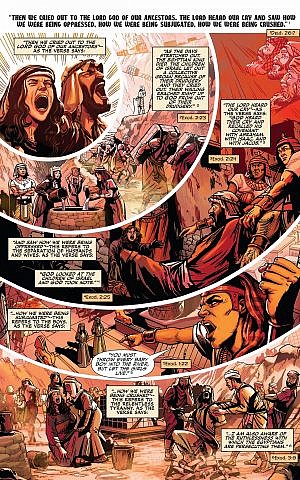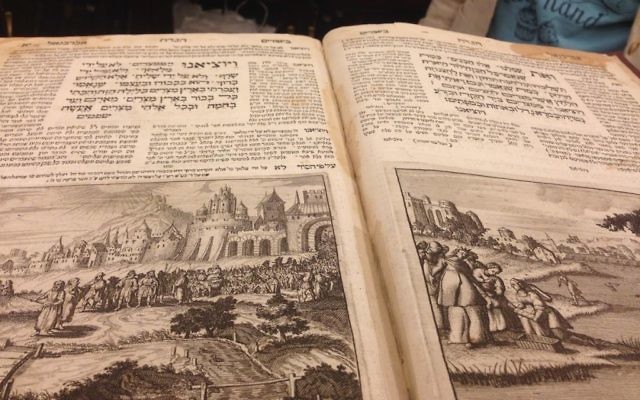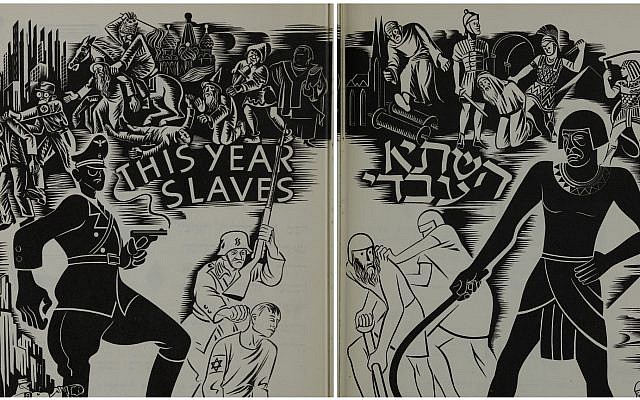In Varshever Is Itst Khoydesh Nisn Peysakh Has Come to the Ghetto Again Sorkmans Circle Haggadah
Just in time for one of the near unusual Passover seder nights in recent retention, acclaimed scholar Vanessa Ochs has come out with a new book on the history of the haggadah.
"The Passover Haggadah: A Biography" is Ochs's contribution to the Princeton University Press Lives of Groovy Religious Books serial, which includes explorations of the Book of Genesis and the letters of Dietrich Bonhoeffer. Yet the haggadah brings some unique challenges.
Although classified as a book, at that place's some dash to its status. "I believe you tin say information technology's a liturgical script, a script for a tabletop liturgy," Ochs told The Times of Israel in a telephone conversation. She calls it "a book that's been revised, reprinted, republished over half-dozen,000 times."
"I don't believe anyone has always been so foolish every bit to write a complete, more than or less, history of the haggadah," Ochs quipped. This history fifty-fifty predates Exodus, when "thousands of enslaved Israelites would take been but a glimmer in the eye, with a prediction to Abraham," and it continues up to the current moment, Ochs said.
Notwithstanding no one could take predicted that mail-publication, Ochs would be fielding inquiries nigh a new kind of haggadah — a virtual one, due to the coronavirus.
"Every hour, I get another request: Practise y'all have a haggadah for a virtual seder, tips for a virtual seder?" Ochs said. "This year, clearly, there will exist haggadot created for the moment."

'The Passover Haggadah: A Biography,' by ordained rabbi and religious studies professor Vanessa Ochs. (Courtesy Princeton University Press)
Although virtual haggadot are non covered in the book, there are enough of others to learn virtually, reflecting a range of authors, fourth dimension periods and places. These include oral versions described in the Mishnah (or Oral Law); printed ones from the Center Ages; and more recent texts reflecting modern Jewish history — the Reform movement and Zionism, the Holocaust and the founding of the State of State of israel, women's rights and Soviet Jewry.
Ochs researched archives in Israel and the Usa, including the Chicago dwelling house of Stephen Durchslag, whom she describes in the book as "the premier private collector of the printed haggadah in America."
Of the six,000 different versions beyond history, Ochs said, "they are probably more alike than they are different. Certain things are generally included."
There are the Four Questions, the Ten Plagues and ane celebrated coffee company — Maxwell House, maker of what Ochs believes is the most popular haggadah of all time. There's the unifying message of "a biblical injunction to fathers to tell the story of the Exodus from Egypt to their children," Ochs writes. Yet in the telling (the literal meaning of the Hebrew term, "haggadah"), some traditions have been updated. Instead of the Four Sons, many haggadot now feature the Iv Children, while Miriam's cup joins Elijah'southward.

From 'Passover Haggadah Graphic Novel' past Hashemite kingdom of jordan B. Gorfinkel and Erez Zadok (Courtesy Erez Zadok)
Ochs describes herself as an "anthropologist who studies contemporary religious practice." An ordained rabbi and professor in the department of religious studies at the University of Virginia, her previous books include the National Jewish Book Award-winning "Inventing Jewish Ritual." She said that working on "Inventing Jewish Ritual" provided invaluable experience when she researched the haggadah, including the phenomenon of women's seders.
"Having learned how it is that new rituals emerge, how they get adopted — that kind of research was bang-up while thinking about this projection," Ochs said. "Certainly it alerted me to the fact that every Jewish do had a trajectory. Every ritual was at ane point new."
Ochs writes that the first haggadot were oral instructions mentioned in the Mishnah and its supplement, the Tosefta. In the Tosefta, she finds "an ad hoc Passover home ceremony taking place between 70 and 200 CE and beyond." Citing Prof. Judith Hauptman, Ochs writes that compared with the Mishnah, the Tosefta'due south haggadah "was briefer and less elaborate," and information technology "may even have come first."
Ironically for those planning virtual seders today, the original seders had their own virtual quality for Jews who could not worship at the Second Temple post-obit its destruction in 70 CE.

An ancient haggadah (thefoundationstone.org)
"Certainly, the seder in the Mishnah grafts ancient practices of the Passover pilgrimage holiday in Jerusalem involving the cede of lambs at the aboriginal temple," Ochs said. "In its identify, information technology became itself the kickoff virtual Passover."
She finds similarities between the seder described in the oral haggadah and the Greco-Roman symposium. Still, she disagrees with scholars who see parallels between the seder and the Last Supper of Jesus.
Amid many Christians, in that location has been an assumption that the Last Supper was a seder
"Amongst many Christians, there has been an assumption that the Last Supper was a seder," Ochs said. "Amidst many Jewish scholars, there is fence. I tend to side with Jewish scholars who believe the Last Supper was not a Passover seder. Rather, at just about every Jewish ceremonial meeting, in that location volition be staff of life and wine, blessings over staff of life and wine."

Biblical scenes in miniature paintings, illuminated in gilded and striking colours. The Golden Haggadah, Catalonia, ca. 1320 CE (courtesy British Library)
As the Diaspora spread from the Center East to Europe, Jews grew concerned most relying on oral tradition for Passover. Ochs said that between the ninth and 11th centuries, they asked the amoraim, or sages, to write downwards instructions. These were originally office of prayer books, but and then became stand-alone volumes. The first printed haggadah was made in Guadalajara, Espana, in 1474. Printed haggadot increased dramatically after the invention of the printing press.
"In one case you accept the printing printing, it ways lots more people tin have their own text," said Ochs, citing "beautiful illuminated texts, clearly for the well-to-do," with some of them "fortunately preserved." These include the Amsterdam Haggadah, first printed in 1695 for a community of Sephardim in the Netherlands, although information technology independent versions for both Sephardic and Ashkenazi readers.
Ochs follows the story equally Judaism grew denominationally in the 19th and 20th centuries, including the first Reform haggadah in 1842. She said that the Reform movement was "quite critical of the traditional text" and instituted some changes.
"The goal was to create a tasteful seder service that would entreatment to the sensibilities of modern man," she said. "The 4 Questions were out. In that location was only a succinct two-office question. Why is this night distinctive, and what is the meaning of this service?"

A wine-stained folio from the aboriginal haggadah in the Schneerson Collection. (Courtesy)
Yet, she reflects, "in some of the haggadot where there were significant exclusions … the communities that created those haggadot eventually returned [parts] of the liturgy that were excluded. The Reform motion in America had early on haggadot that did non accept the plagues. Only they came back."
America is the birthplace of some other, more enduring development. It began in the 1920s, when a certain coffee visitor decided on a marketing venture aimed at the Jewish customs. Although the company was non Jewish, it adopted the recommendation of a Jewish advertiser — the Joseph Jacobs Advert Agency — and the Maxwell House Haggadah was built-in.
The Reform motility in America had early haggadot that did non accept the plagues. But they came back
Ochs said that the "idea of a branded haggadah was quite curious," noting in the volume that in that location is not, for example, a Kleenex Lamentations. However the text was both complimentary and traditional, and it became a Passover staple. Ochs can recite its transliterated Ashkenazi pronunciation of the start of the Four Questions from memory: "Mah nish-ta-naw…"

A Maxwell Firm Java company Haggadah. (JTA)
"Information technology'south been revised and so many times since the 1920s," Ochs said, noting last twelvemonth's The Marvelous Mrs. Maisel Haggadah, a partnership betwixt the striking prove, Maxwell Business firm and Amazon Prime number that included gender-neutral linguistic communication simply kept the Ashkenazi pronunciation. Ochs recently spoke with someone who grew up reading the Maxwell Business firm Haggadah in Cuba, and noted that copies have been sent to Israel. "I'g sure, in the former Soviet Marriage, it was sent over with boxes of matzah," she said.
Ochs also addresses what she calls "haggadot of darkness," oral and written versions created when Passover occurred in times of unimaginable tragedy — notably the Holocaust.
"It's incredible what people needed to do if they did not have a haggadah," Ochs said. "Some people took one with them as a treasured possession that they were able to hold on to." For those without a haggadah, "individuals, [based on] what they could call up, even without the materials for a seder, would recite the words," Ochs said. She added, "the idea that … however dark the time was, the impulse to mark sacred time and memory with the hope of redemption was so powerful."

A folio from the 'Survivors' Haggadah' written for the 1947 Survivors' Seder in Munich, Germany (Courtesy National Library of Israel)
1 particularly powerful narrative for her is that of the Landau family of Poland. A not-Jewish Polish family sheltered them and let them kosher their oven for Passover. Patriarch Shmaryahu Landau recited the haggadah from retentiveness to his 17-year-old son Elimelekh, who wrote it down in an illustrated version that is now at Yad Vashem.
Elimelekh Landau subsequently moved to Mandatory Palestine and served with the Haganah during the War of Independence. His battalion cruel under siege, and during Passover, he typed upwardly another haggadah, for his boyfriend soldiers; it is too at Yad Vashem.

A children's Haggadah from 1945 compares draws parallels between the Passover narrative and the Holocaust. (Yeshiva University Museum/Center for Jewish History/via JTA)
Ochs noted that the 1974 edition of the Reform haggadah reflected the Shoah through writings from Anne Frank, Elie Wiesel and Martin Buber. And, she said, "the Reform movement's mental attitude toward the State of Israel had shifted," including an emphasis of the phrase that ends the traditional haggadah, "next year in Jerusalem" or "Fifty'Shana haba'ah b'Yerushalayim."
This phrase has taken on added complexity in modern history. "After the Half dozen 24-hour interval War, there were all types of options and celebrations," Ochs said. "Certainly, haggadot in that era, thinking about 50'Shana haba'ah b'Yerushalayim, quite certainly American Jews were thinking near the joy about Israel."

A page from the haggadah written by the 36a Palmach Third Battalion for Passover 1948 (Courtesy National Library)
Ochs said she presumes there is likewise "a minor segment" who intend the phrase to hateful "that they are looking toward a time when there is a tertiary temple, when temple sacrifices in one case once again resume."
Yet, Ochs said, "L'Shana Haba'ah B'Yerushalayim, to my understanding, was never about going to, literally traveling to, a item place. Information technology's about a messianic hope of the ultimate community of Jerusalem, a messianic era of peace, completion, more and so than physically traveling."
Physical travel looks unlikely this Passover. Merely however Jews celebrate, perhaps they can observe some hope by learning from Ochs's volume how the haggadah has endured in challenging circumstances. Peradventure information technology will give hope that the haggadah tin can assistance people make it through a similarly challenging virtual seder this year.
Source: https://www.timesofisrael.com/this-years-virtual-seders-have-an-ancient-echo-says-haggadah-historian/
Belum ada Komentar untuk "In Varshever Is Itst Khoydesh Nisn Peysakh Has Come to the Ghetto Again Sorkmans Circle Haggadah"
Posting Komentar